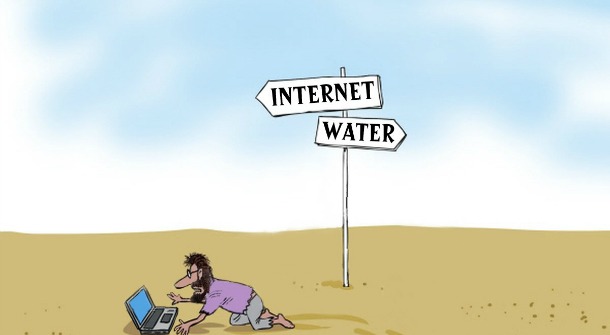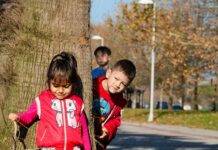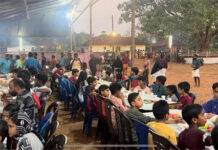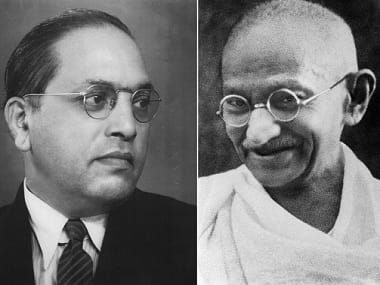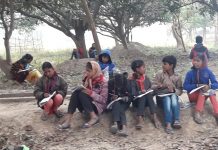At a school in Wazirabad, Hindus and Muslims compose two different sections; amidst an already fractured national consciousness has schooling failed its inclusive purpose?
Ananya Pathak | The New Leam
 Image Source : Wikimedia Commons
Image Source : Wikimedia Commons
[dropcap]S[/dropcap]chools are not neutral spaces much against what we would like to assert, in fact through the propagation of what is considered as ‘official knowledge’, they continue to divide, segregate, discriminate and alienate a range of children.
From Dalits in a school where most other students are from the upper castes, to girls in a patriarchal society that taboos women’s education, to Muslims in a predominantly Hindu school and the children from the EWS category in a middle class private school- everyone who does not fit into the dominates model of the ‘normal’ faces alienation at the school.
From jokes that are born out of prejudice, to comments about sartorial and culinary preferences, to sophisticated denial of the capability of the ‘other’- children from the marginalised communities face difficulties not only in their dealings with the school administration but also amidst a group made up of fellow students.
The Conscience of Fractured Intellect
Recently, while reading a book called ‘Mothering a Muslim: The Dark Secret in Our Schools and Playgrounds’ by Nazia Erum once again I realised that it is through our schools that we are laying the seeds of social reproduction at a time when these schools could play such an important role in cultivating a sense of love and sharing across economic, religious and social boundaries.
[irp posts=”6617″ name=”Difficulties in Mothering a Muslim”]
Are you associated to the Taliban, are you a Pakistani, how many wives does your father have and do your family members produce bombs at home? These were some of the questions that Muslim children in predominantly Hindu schools are compelled to hear on an everyday basis accompanied by prejudiced ideas that teachers hold about them and the attitude of ‘discomfort’ that the administration shows towards them.
Schools are laying the seeds of communal disharmony in our society by addressing prejudiced ideas, communal jokes and misbeliefs that communities have about each other not only through overt support but through subtle ways like showing surprise when a Muslim student opts for Sanskrit as the third language, or expressing discomfort in requesting a Muslim student to bring food from her home in a collective class picnic due to the belief that their food is unclean or will not be appreciated by the majority students who are Hindus. It is not only religion that has caused immense stigmatisation in our schools but also caste and class have often been sources of exploitation of the weak by the mighty.
Taking for Granted what ought to be questioned
Why must a Dalit child sit on the same mat with a bunch of upper caste students in a remote Indian school? Why must a Dalit girl not be the right choice for cleaning and sweeping the school compound when the man employed for the task takes a leave?
Similarly the plight of children from economically weaker sections in middle class schools despite the intention of inclusion is immensely sad.
Stereotypes about ‘poor’ people’s hygiene and health, their language and learning capability, their behavioural and attitude related problems all reach the class much before they themselves do. Moreover alienation in terms of inability to access fancy clothes, gadgets and parental occupation- time and again present uncomfortable situations for most such children and it is ideationally a very traumatic experience that they have to go through.
In fact the ideas of thinkers like Paul Willis ( Learning to Labour, 1977)and Basil Bernstein(Class, Codes and Control: Theoretical Studies Towards a Sociology of Language,1971) when they write about the segregation that happens in schools due to the economic backgrounds of students, how their own cultures and value systems are systematically suppressed, how the curriculum undermines their parent’s occupation(largely manual)as inferior to white collar occupations that are seen as the ideal in education come refreshingly alive in our Indian school context.
Paul Willis would talk about the creation of resistance and the formation of a counter-culture among such students as a way of responding to the school and its broader agenda that suppressed the voices of many who came from the margins.
This counter culture enabled them to understand that no matter how hard they worked and contrary to popular perception, the school could never be an equalising agent and was bound to reproduce the economic inequality through training people to take up jobs according to class.
They became almost immune to the paradox called schooling and this resulted in an acceptance that nothing could be done to redefine schooling in a manner that it became an emancipatory experience for all. Although we don’t know how much of a counter-culture can be seen in our Indian schools but we can witness that this symbolic violence that we perpetrate in our schools on a large section of students from the minority (whether gender, culture, religious or economic) remains unchallenged and is often taken for granted.
When Schools Missed the Opportunity
Amidst enough communal disharmony in the nation and much ado about cultural aspects like food choice and marriage customs amongst the two rival communities, it is ironic that when schooling as a process of educational dissemination had the potential to instill egalitarian and shared values, it chose to light up the fire even more. It is heart-breaking to know that a school in Delhi’s Wazirabad is segregating students based on communal lines into different sections.

The argument that was given by the administration was that to avoid frequent communal fights among students it was necessary to keep the Hindu kids away from the Muslim kids because they had different food choices, cultures and ways of doing things.
Moreover, since the Navratra festival is here, many Hindu students expressed discomfort about sharing the ‘non-veg tiffin’ of their Muslim counterparts. The concerned teachers of the school went to the Zonal Officer to complain about the matter but they did not take a written complaint from them for the fear of being targeted.
It is ironic that from such a young age, children are being taught to be intolerant and separated in terms of religious affiliations. Putting all Muslim children together and all Hindu children together is surely not the way towards a peaceful society.
Do Hindu and Muslim children not fight amongst themselves and moreover what is the purpose of schooling if it does not train us to collectively live in society, learn from a diverse range of cultures, accept and allow differences to flourish and celebrate this diversity?
It saddens me to think that when children learn about diversity of language, religion and culture through their history textbooks and continue to face discrimination and prejudice on a day to day basis- will this grand narrative of ‘unity in diversity ‘hold any meaning before their innocent minds?
Surely something has gone terribly wrong with our education system that has not been addressed adequately by the society. It is ironic that instead of planting the seed of fraternity in schooling, we are encouraging intolerance.
This brings us at a juncture where we must address our educational crisis and avoid the fractured conscience that is being nourished in our schools by creating a system that is truly inclusive.



